2018 - 2019 Funded Research Projects
The Cornell Feline Health Center Research Grant Program provides vital financial support to Cornell researchers investigating issues that affect feline health. Projects currently funded by the Cornell Feline Health Center range from studies of feline infectious peritonitis (FIP) to finding the genetic causes of certain inherited diseases.
Scientific research has made feline medicine what it is today, and it’s making a healthier, happier tomorrow possible for cats around the world. If you believe in the positive power of our work to make a difference, please consider making a donation to the Cornell Feline Health Center today.
A novel miRNA-based approach for enhancing T cell immunotherapy in cats
Recent advances have shown that the immune system can be used to combat cancer. One strategy that is used to recruit the immune system in the fight against cancer is to remove particular types of immune cells found in the bloodstream of patients with cancer, stimulate them to mount a response against their particular tumor cell type in the laboratory, and then reintroduce these immune cells into the bloodstream of the patient, where they can recognize and destroy all of the tumor cells in the body of the patient.
This study is focused on understanding how the use of small molecules called micro RNAs (miRNAs) can improve the ability of feline “killer” T cells, a type of white blood cell involved in the immune response, to destroy specific tumor cell types in cats.
Investigator: Brian Rudd, MPH, PhD
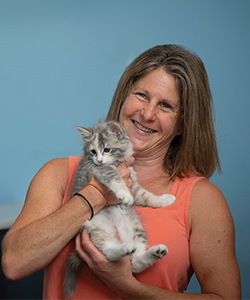 Liquid biopsy: identifying blood biomarkers of feline mammary and squamous carcinomas
Liquid biopsy: identifying blood biomarkers of feline mammary and squamous carcinomas
Most diagnoses of a common type of cancer in cats called carcinomas are made by obtaining a biopsy of a tumor - a process that can be invasive, most commonly requires anesthesia, and can be inaccurate due to biopsy sampling sites chosen. Carcinomas are commonly spread through the blood stream from their initial site of origin to other parts of the body (termed metastasis) via the spread of tumor cells in the bloodstream. These circulating tumor cells (CTCs) can be detected and quantified in the blood stream of human carcinoma patients to make diagnoses and provide information about prognosis (termed liquid biopsy), but this technology has not previously been applied to feline carcinoma patients.
This study is investigating ways to optimize our ability to apply liquid biopsy to improve our ability to diagnose two types of feline cancer: mammary and squamous cell carcinoma.
Investigator: Tracy Stokol, BVSc, PhD, DACVP
Effect of method of subcutaneous tissue closure on post-operative pain and incisional complications in cats undergoing midline laparotomy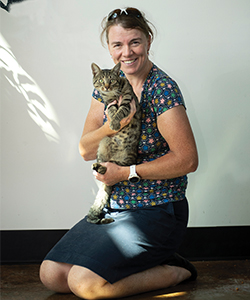
A laparotomy is a surgical procedure that involves making an incision into the abdominal wall. There are many reasons for a cat to undergo a laparotomy (i.e. spay, intestinal obstruction, surgical biopsy), but they share a common need to close the incision so that it heals properly. There are a number of different techniques that can be used to achieve closure of the surgical site of a laparotomy, but data addressing the best technique to achieve closure of laparotomy sites in cats are lacking.
The goal of this study is to determine which method of closure of midline laparotomy sites minimizes post-operative pain and complications in cats undergoing elective spay.
Investigator: Galina Hayes, BVSc, MRCVS, PhD
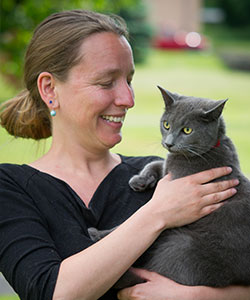 The use of povidone-iodine ophthalmic compositions as a broad-spectrum therapy for ocular infections in cats
The use of povidone-iodine ophthalmic compositions as a broad-spectrum therapy for ocular infections in cats
Eye infections are fairly common in cats, and they can be caused by a variety of viruses and bacteria. In many cases, more than one organism is responsible for feline eye infections, and identification of the specific organisms involved in these co-infections can be challenging. An understanding of how different organisms that cause feline eye infections interact with one another, and a therapy that can be used to treat a broad spectrum of organisms that cause eye infections in cats has the potential to significantly improve the prognosis for cats with a variety of eye infections.
This study is investigating how a variety of bacteria and viruses that commonly cause feline eye infections interact with one another during co-infections, and the effectiveness of povidone-iodine-based ophthalmic preparations as a broad-spectrum therapy for the treatment of these infections.
Investigator: Gerlinde Van de Walle, DVM, Ph.D.
Study of the extra-cardiac factors associated with feline hypertrophic cardiomyopathy
Hypertrophic cardiomyopathy (HCM) is the most common heart disease in cats. In spite of its prevalence and significant efforts to figure out how HCM develops, the mechanism of how this disease develops remains unclear. Obesity is also quite common in cats, and although a causative relationship between obesity and the development of HCM in cats has been proposed, studies designed to investigate the role of obesity in the development of HCM are lacking.
The goal of this study is to evaluate the relationship between a variety of metabolic markers of obesity and the incidence of HCM as a preliminary step in investigating the role of obesity in the development of HCM.
Investigator: Kathleen Kelly, DVM, PhD, DACVP
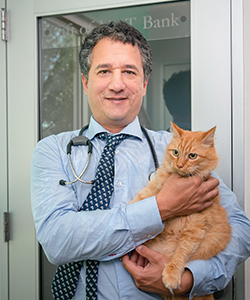 Using omics techniques to define microbial pathogenesis of periodontitis in the domestic cat
Using omics techniques to define microbial pathogenesis of periodontitis in the domestic cat
Periodontal disease is common in cats and has been implicated in a variety of health problems including obesity, cardiovascular disease, and diabetes mellitus. While it is known that this inflammatory condition is caused, in part, by a complex interplay between oral bacterial populations and the immune system of affected cats, the exact mechanism of the development of periodontal disease in cats remains elusive.
This study will utilize cutting edge molecular biology techniques (i.e. DNA analysis) to characterize the bacterial populations found in naturally occurring cases of feline periodontitis. The results of this study are expected to significantly improve our understanding of the mechanism of feline periodontal disease, which is expected to improve our ability to prevent and treat this common feline health problem.
Investigator: Santiago Peralta, DVM, DAVDC
A multidimensional approach to the characterization of neurologic feline infectious peritonitis
Feline infectious peritonitis (FIP) is a devastating disease of cats that generally carries a very poor prognosis. Occurring in either a “wet” form, in which fluid accumulates in body cavities, and a “dry” form, which is commonly associated with neurologic problems, FIP results when the ubiquitous and usually well-tolerated coronavirus mutates to an almost routinely lethal form of the virus. While our understanding of how this virus becomes so deadly has improved significantly over the past decade, there is still much to learn in our effort to identify ways to improve our ability to diagnose, treat, and prevent both forms of FIP.
This study is investigating the genetic and biochemical signatures of naturally occurring “dry” FIP using samples from cases of FIP in which cats show neurologic signs. The information gleaned from this study will likely provide vital insight into the mechanism of neurologic abnormalities seen in the “dry” form of FIP.
Investigator: Gary Whittaker, PhD
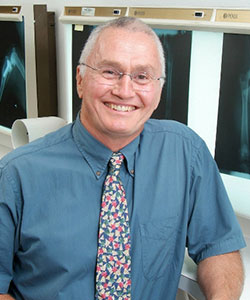 Common resources for feline genomics: whole genome and transcriptome sequencing of universal controls
Common resources for feline genomics: whole genome and transcriptome sequencing of universal controls
An understanding of the genetic bases of a variety of feline diseases has the potential to dramatically improve our ability to diagnose, treat, and prevent these conditions, thereby improving feline well-being. Recent advances in the sequencing of DNA and RNA provide the opportunity to clarify these genetic mechanisms, and an important part of figuring out genetic problems in cats with various diseases is establishing what is genetically “normal” in cats. By comparing the genetics of a cat with a given disease to the genetics of normal (control) cats, the possibility of identifying the genetic basis of that disease is strengthened significantly.
This study will focus on identifying cats that are normal with respect to a variety of organ systems (i.e. heart, liver, nervous system, musculoskeletal system) by carrying out clinical evaluations by specialists in these respective areas, and then harvesting genetic samples from these cats to establish a bank of normal controls to which the genetics of cats with a variety of clinically important disease can be compared.


